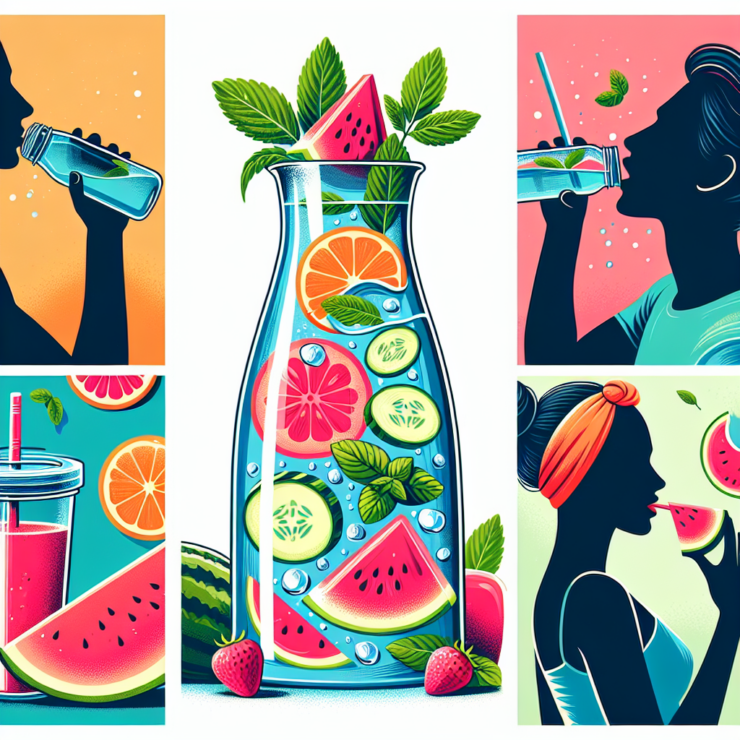The Importance of Staying Hydrated
Understanding Dehydration and Its Effects
Dehydration occurs when the body loses more fluids than it takes in, leading to an imbalance that affects various physiological functions. Busy professionals often neglect their water intake, which can lead to mild or severe dehydration, depending on the deficit of water in the body.
The effects of dehydration can be detrimental to both physical and cognitive performance. Individuals may experience symptoms such as fatigue, dizziness, confusion, and extreme thirst. For the busy professional, these symptoms can translate into reduced productivity, impaired decision-making, and overall lower work quality.
| Mild Dehydration Symptoms | Severe Dehydration Symptoms |
|---|---|
| Dry mouth | Extreme thirst |
| Fatigue | Dizziness or lightheadedness |
| Headache | Rapid heartbeat |
| Decreased urine output | Rapid breathing |
| Dry skin | Sunken eyes |
The Science of Hydration in the Body
Hydration is not merely about quenching thirst; it’s a fundamental process that supports various body functions. Water is the medium through which nutrients and waste products are transported, temperature is regulated, and tissues are lubricated.
The body’s hydration status is tightly regulated by the kidneys, which adjust the volume and concentration of urine excreted based on hydration levels. When fluid intake is low, the body conserves water, resulting in concentrated urine. Conversely, with adequate hydration, the kidneys can flush out excess fluids and waste products efficiently, as indicated by lighter urine color.
Maintaining optimal hydration is essential for ensuring that all body systems function correctly. It supports digestion, aids in joint health, and plays a crucial role in maintaining cardiovascular stability. For busy professionals, understanding the science behind hydration can be empowering, leading to more mindful drinking habits and better overall health.
| Body Function | Impact of Hydration |
|---|---|
| Nutrient transport | Facilitates the delivery of essential vitamins and minerals |
| Waste removal | Aids kidneys in flushing out toxins |
| Temperature regulation | Distributes heat and promotes cooling through sweat |
| Tissue health | Keeps mucous membranes moist and protects organs |
By comprehending the importance of staying hydrated and the adverse effects of dehydration, professionals can take proactive steps to incorporate the best ways to hydrate into their daily routines, thereby enhancing their health and work performance.
Recognizing Dehydration
Staying adequately hydrated is a cornerstone of good health, yet it’s often neglected by busy professionals. Recognizing the early signs and symptoms of dehydration is critical for maintaining hydration levels and supporting overall wellness.
Signs and Symptoms of Dehydration
Dehydration occurs when the body loses more fluids than it takes in. It can manifest through a range of signs and symptoms, which may vary from mild to severe. It’s crucial for individuals to be aware of these indicators to prevent the negative effects of dehydration.
| Mild to Moderate Dehydration | Severe Dehydration |
|---|---|
| Thirst | Extremely dry mouth and skin |
| Dry mouth | Sunken eyes |
| Fatigue | Rapid heartbeat |
| Decreased urine output | Rapid breathing |
| Dry skin | Confusion or irritability |
| Headache | Fainting |
| Dizziness or lightheadedness | Lack of urination for eight hours |
| Dark yellow urine | Lethargy |
These symptoms serve as the body’s warning signals that it needs more fluids. By responding promptly to these cues, individuals can take immediate steps to rehydrate.
The Risks of Chronic Dehydration
Chronic dehydration is a persistent state of inadequate hydration which can have serious health implications. When the body is frequently dehydrated, it can lead to various risks and long-term health issues.
| Health Risks | Description |
|---|---|
| Kidney Stones | Concentrated urine can lead to the formation of kidney stones. |
| Urinary Tract Infections | Insufficient fluid turnover can increase the risk of infections. |
| Chronic Kidney Disease | Prolonged dehydration can affect kidney function over time. |
| Cognitive Impairment | Dehydration can impact concentration, memory, and mood. |
| Digestive Issues | Lack of fluids can result in constipation and other digestive problems. |
| Skin Health | Dehydration can make the skin more vulnerable to skin disorders and wrinkling. |
For busy professionals, understanding the importance of hydration and recognizing the signs of dehydration are vital steps towards sustaining their health and productivity. Incorporating the best ways to hydrate into daily routines can help mitigate these risks and ensure optimal bodily function.
Hydration Strategies for Busy Professionals
Maintaining adequate hydration is a critical component of health, especially for professionals who are engrossed in their work. With demanding schedules and pressing deadlines, it’s easy to neglect water intake. The following strategies can help busy individuals stay hydrated throughout the day.
Establishing a Hydration Routine
Implementing a hydration routine is a practical way to ensure consistent water intake. One could start by consuming a glass of water upon waking and continue by drinking water at set intervals throughout the day.
| Time of Day | Hydration Activity |
|---|---|
| Morning | Drink a glass of water after waking up |
| Breakfast | Pair meal with a glass of water |
| Mid-Morning | Refill water bottle and sip |
| Lunch | Consume water or hydrating beverages |
| Mid-Afternoon | Take a water break or drink herbal tea |
| Evening | Hydrate during dinner |
| Night | Glass of water before bedtime |
Adapting a routine to individual schedules and preferences is essential. For some, integrating hydration with regular activities, such as meetings or breaks, can serve as an effective reminder to drink water.
Setting Reminders and Goals
For professionals preoccupied with their work, setting reminders on phones or computers can prompt them to drink water regularly. Employing reminder apps or calendar notifications can be effective in establishing this habit.
Goals can also motivate individuals to drink more water. Aiming to finish a certain number of water bottles or glasses by the end of the day encourages increased water consumption. Tracking progress can be gratifying and reinforce the habit.
| Goal | Description |
|---|---|
| Daily Intake | Aim to consume at least 8 glasses of water |
| Bottle Milestones | Finish a water bottle by midday and one by the end of work |
| Hydration Before Meals | Drink a glass of water 30 minutes before each meal |
By setting attainable hydration goals and utilizing reminders, busy professionals can make water consumption a regular part of their day, leading to better health and improved performance at work.
Best Ways to Hydrate Throughout the Day
Maintaining adequate hydration is a cornerstone of good health, especially for busy professionals who may not prioritize their water intake. Here are some of the most effective strategies to ensure proper hydration throughout the day.
Water: The Gold Standard for Hydration
Water is the most essential and straightforward means to stay hydrated. It is recommended that individuals consume a certain amount of water daily, although specific needs can vary based on factors such as activity level, climate, and overall health.
| Gender | Recommended Daily Water Intake |
|---|---|
| Women | About 2.7 liters (91 ounces) |
| Men | About 3.7 liters (125 ounces) |
These recommendations include total water intake from all beverages and foods. For those who struggle with drinking plain water, adding a slice of lemon, lime, or cucumber can enhance the flavor, making it more palatable.
The Role of Electrolytes in Hydration
Electrolytes, such as sodium, potassium, and magnesium, play a vital role in maintaining proper hydration. They help regulate fluid balance, nerve signals, and muscle contractions. When hydrating, especially during periods of heavy sweating, it’s important to replenish electrolytes.
Incorporating beverages that contain electrolytes can be beneficial, particularly for those engaged in prolonged physical activity. Electrolyte-rich drinks can include certain sports beverages, coconut water, and even a homemade solution of water with a pinch of salt and a squeeze of citrus.
Incorporating Hydrating Foods into Your Diet
In addition to drinking fluids, consuming foods with high water content can significantly contribute to daily hydration needs. Many fruits and vegetables are not only nutritious but also naturally rich in water.
| Food | Water Content Percentage |
|---|---|
| Cucumber | 96% |
| Watermelon | 92% |
| Strawberries | 91% |
| Spinach | 93% |
By including a variety of these hydrating foods in meals and snacks, individuals can boost their water intake effortlessly.
Understanding the Benefits of Herbal Teas and Infusions
Herbal teas and infusions are another excellent way to hydrate. Unlike caffeinated teas and coffee, which can have a diuretic effect, herbal teas contribute to overall fluid intake without the risk of dehydration.
Herbal teas come in a wide range of flavors and can be enjoyed hot or cold. In addition to their hydrating properties, many herbal teas offer health benefits, such as anti-inflammatory effects and relaxation.
It’s important for professionals to find hydration methods that fit into their busy lifestyles. From carrying a reusable water bottle to choosing hydrating foods and beverages, these strategies can help maintain hydration throughout the day. Staying properly hydrated can improve cognitive function, physical performance, and overall well-being, making it a crucial element for success in any high-stress environment.
Hydration Myths and Facts
In the realm of health and wellness, there are numerous myths surrounding the concept of hydration. These myths can often lead to confusion about the best ways to hydrate. It’s crucial to dispel these myths with evidence-based facts to ensure proper hydration practices are followed.
Busting Common Hydration Myths
Myth 1: You need to drink eight glasses of water a day.
While the eight-glasses rule is easy to remember, hydration needs are individualized and depend on factors such as weight, climate, and activity level.
Myth 2: If you’re not thirsty, you’re hydrated.
Thirst isn’t always a reliable indicator of hydration status. Often, by the time one feels thirsty, they may already be dehydrated.
Myth 3: Hydration only comes from water.
Although water is crucial, other beverages and even foods can contribute to overall hydration.
Myth 4: Drinking water can help you lose weight.
Water consumption alone doesn’t cause weight loss but can aid in a weight loss regimen by substituting for high-calorie drinks and promoting satiety.
Myth 5: You can’t drink too much water.
It is possible to overhydrate, which can lead to water intoxication or hyponatremia, where the sodium levels in the bloodstream are diluted.
Evidence-Based Hydration Facts
To clarify the best ways to hydrate, let’s examine some evidence-based hydration facts:
Fact 1: Individual hydration needs vary.
Daily fluid intake recommendations can differ based on various physiological and lifestyle factors.
Fact 2: Various symptoms can indicate dehydration.
Signs of dehydration include dry mouth, fatigue, dark urine, and headache.
Fact 3: Many foods contribute to hydration.
Fruits and vegetables like cucumbers, oranges, and watermelon have high water content and can help maintain hydration.
Fact 4: Electrolytes are important for hydration.
Electrolytes, such as sodium and potassium, help retain fluid and maintain body functions.
Fact 5: Athletes have unique hydration requirements.
Those engaging in prolonged physical activity may need to consume sports drinks that contain electrolytes to replenish what is lost through sweat.
By understanding and acknowledging these myths and facts, busy professionals can adopt effective and individualized hydration strategies to suit their active lifestyles.
Hydration and Exercise
Maintaining hydration is paramount for active individuals who engage in regular exercise. Exercise increases fluid loss through sweat and respiration, making it essential to replenish the body’s water supply appropriately.
Hydration Needs for Active Individuals
The hydration needs of active individuals can vary depending on the intensity and duration of the exercise, as well as environmental conditions. It is generally recommended to drink water before, during, and after physical activity to maintain optimal performance and recovery.
Here is a simple guideline for hydration before, during, and after exercise:
| Activity Stage | Hydration Recommendation |
|---|---|
| Pre-Exercise (2-3 hours before) | 17-20 ounces of water |
| Pre-Exercise (20-30 minutes before) | 8 ounces of water |
| During Exercise (Every 10-20 minutes) | 7-10 ounces of water |
| Post-Exercise | 16-24 ounces of water for every pound of body weight lost |
Post-Workout Rehydration Tips
Rehydrating after exercise is crucial to recovery and the body’s overall well-being. Here are some tips to ensure effective rehydration post-workout:
- Replenish Fluids Gradually: Instead of ingesting large quantities of fluid right after exercising, aim to drink smaller amounts at regular intervals to facilitate better absorption.
- Include Electrolytes: Since sweat loss includes electrolytes like sodium and potassium, it’s beneficial to consume drinks that contain these electrolytes to restore balance.
- Monitor Urine Color: A pale yellow color typically indicates proper hydration, while darker urine suggests a need for more fluids.
- Listen to Your Body: Thirst is a signal of dehydration, so make sure to drink fluids even before you feel thirsty, especially after exercising.
- Weigh Yourself: Weighing before and after exercise can help determine fluid loss. Drinking 16-24 ounces of water for every pound lost can aid in replenishing the body’s water content.
By following these hydration strategies, busy professionals can ensure that their exercise routines do not compromise their hydration status, allowing for better health, performance, and recovery.
Monitoring Your Hydration Levels
Maintaining proper hydration is crucial for overall health, especially for busy professionals who may neglect their water intake. Monitoring hydration levels can help prevent the negative effects of dehydration.
Using Urine Color as a Hydration Indicator
One of the simplest ways to monitor hydration is by observing the color of urine. Generally, urine color ranges from pale yellow to deep amber, depending on the level of hydration.
| Urine Color | Hydration Level |
|---|---|
| Pale Straw | Well Hydrated |
| Transparent Yellow | Normal Hydration |
| Dark Yellow | Normal to Mild Dehydration |
| Amber or Honey | Mild to Moderate Dehydration |
| Syrup or Brown Ale | Severe Dehydration |
It’s important to note that various factors can affect urine color, including the intake of certain foods, vitamins, and medications. However, using this chart as a guideline can provide a quick and easy reference for one’s hydration status.
The Role of Technology in Tracking Hydration
Technology can also play a significant role in helping individuals keep track of their hydration. There are a variety of apps and devices designed to monitor water intake and remind users to drink water throughout the day.
These technological tools often feature:
- Personalized hydration goals based on individual factors such as weight, height, and activity level.
- Notifications and reminders to drink water at regular intervals.
- Tracking of historical intake to ensure consistent hydration over time.
- Integration with other health and fitness apps to provide a comprehensive overview of one’s wellness journey.
By leveraging technology, busy professionals can ensure they are meeting their hydration needs without having to constantly focus on it throughout their busy day. With automated reminders and personalized goals, staying hydrated becomes a manageable and integrated part of a healthy lifestyle.











